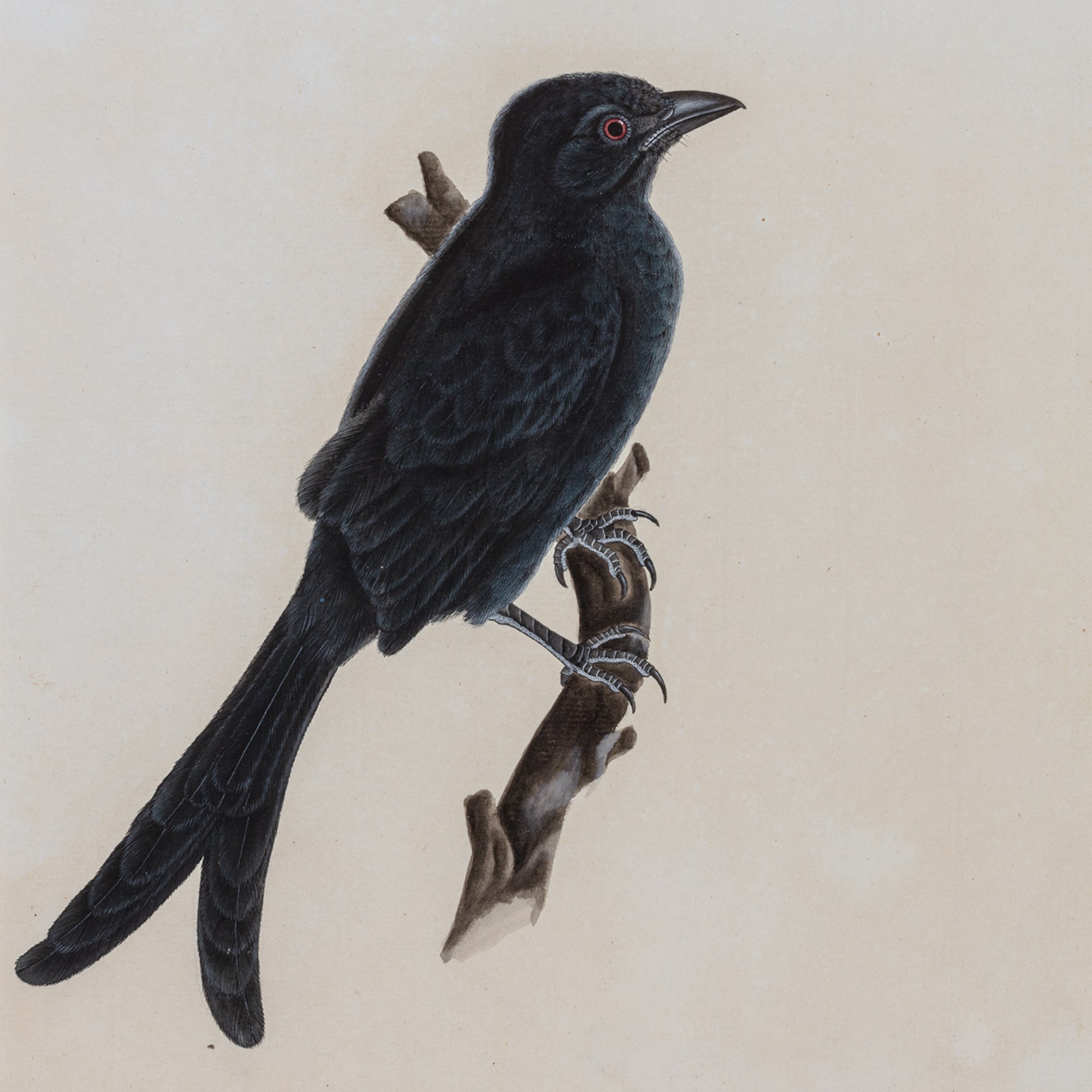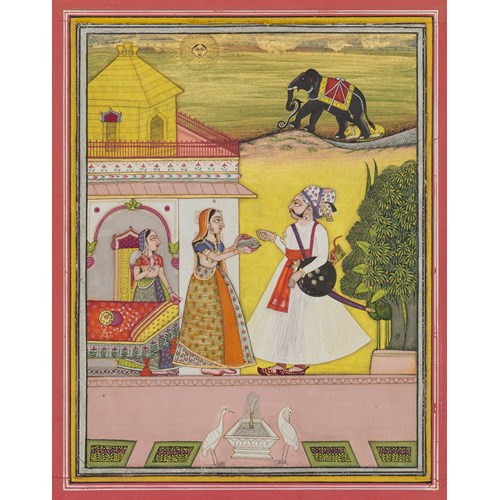A Study of an Ashy Drongo, Dicrurus leucophaeus
Date c. 1800
Period 19th century
Origin Calcutta, India
Medium Watercolour on Fleur de Lys watermark paper
Dimension 47 x 27 cm (18¹/₂ x 10⁵/₈ inches)
A member of the Dicruridae family, populations occur across South and Southeast Asia.
Preferring open forest in mountainous regions such as the Himalayas, they conduct aerial sallies, capturing insects in mid-flight. The birds are also known to eat blossoms such as those of the eucalyptus tree and also, occasionally, smaller birds and lizards. They have also been observed riding on the backs of sheep and buffalo, whilst feeding upon insects. Whistler (p. 158) describes the Ashy Drongo as “a magnificent flier, turning and twisting with extreme speed and skill, and it has the pugnacity of the family, hunting larger birds from the vicinity of its nest with great courage.” Both sexes collaborate in nest building, with the males producing materials and the females overseeing the construction. A clutch of four to six eggs is laid in a loose cup nest made of roots, lichens and spiders webs. The birds emit a pleasant, chattery and sometimes nasal call and have been known to mimic other birds.
Ashy drongos can exhibit plumage in varying shades of grey with the presence of white patches around the eye of some birds. However, with very dark feathers, Longicaudatus, a subspecies in India bears more likeness to the Black Drongo, although it has a longer tail and brighter red eye.
The present bird has predominately black feathers with a wisp of grey supercilium above the eye. The chest feathers are also a paler greyish-black, with hints of brown tones on the primaries. Despite its charcoal black appearance, the plumage also reveals a subtle iridescence, and, on close observation the feathers appear to shimmer with exquisite deep blue-green tones.
The work itself may be regarded as a celebration of fine detail, as seen in the delicate whiskers around the bird’s beak and glimmer of light reflecting upon the iris. Dense clusters of feathers on the forehead are also rendered with extremely refined brushstrokes. Overall there is a symbiosis between the confidence of this majestic bird and that of the hand of the artist, who has succeeded in their animated presentation of this elegant species.
Bhujjangah written in pencil on recto and below this ‘Fork tailed shrike’.
For additional ornithological studies made for Lord Valentia, see Sotheby’s Sven Gahlin Collection, Lot 36 a drawing of a bustard, and Lot 37 a watercolour of a crow-pheasant, both made for Lord Valentia; Sotheby’s, London, 31 May 2011, The Stuart Cary Welch Collection, Part Two, lot 115; see also Welch 1976, no.26; Welch 1978-I, nos.18a-c.and Leach 1995, no.7.96, pp.760-2. For two bird studies donated by Viscount Valentia to Lord Wellesley, see British Library in London (Wellesley Collection, NHD 29, vol. iv, f.21,27)
Literature
Hugh Whistler, 1949. Popular Handbook of Indian Birds. Edition 4. Gurney and Jackson, London, pp. 158–59.
Craig, Robson, 2005. Birds of Southeast Asia. Princeton University Press. Ashy Drongo, p. 176.
Stock no.: A5498
Date: c. 1800
Period: 19th century
Origin: Calcutta, India
Medium: Watercolour on Fleur de Lys watermark paper
Dimension: 47 x 27 cm (18¹/₂ x 10⁵/₈ inches)
Provenance:
George Annesley, 2nd Earl of Mountnorris and Viscount Valentia (1769-1844), was a passionate amateur naturalist with a particular interest in ornithology. Following a career in the army, he travelled to India in 1802 where, inspired by his encounters with professional botanists and zoologists, he commissioned a number of natural history paintings.
During his four-month residency with Saadat Ali Khan, Nawab of Oudh (r. 1798-1814), the Viscount was much enthused by the ruler’s additions to his ornithological collection; “he sent people into his woods to bring me rare birds and plants; he laid a dawk two hundred miles to bring them down to me in a state of perfection.” (Viscount Valentia, 1809, p. 172.)
In 1803 he stayed with Lord Wellesley (the elder brother of the first Duke of Wellington) and visited his menagerie in Barrackpore, Calcutta. Viscount Valentia gifted Wellesley two bird studies from his collection, now in the British Library, London (see M. Archer, Natural History Drawings in the India Office Library, London, 1962, p. 96). The works bear his personal Indian seal, “The Right Honourable Lord Bahadur Viscount Valentia.”
Returning to England in 1806, the Viscount became a member of parliament and wrote a three- volume series chronicling his travels, Voyages and Travels to India, Ceylon and the Red Sea, Abyssinia and Egypt in 1802-06. Published in 1809, the books were illustrated by his draughtsman and secretary Henry Salt. Continuing his interest in the natural world, Annesley became a member of the Royal Society and subsequently his collection has become the subject of an important series of natural history studies, celebrating India’s rich ecological biodiversity.
Of the current series of paintings, four bear the Viscount’s personal Indian seal, “The Right Honourable Lord Bahadur Viscount Valentia 1217 (1802-3)”, while three others have a seal in exactly the same ink as the works with a personal seal. Considering this and that the paintings display such a great likeness to one another, it is highly probable that they were commissioned by the Viscount and undertaken by the same artists. Drawing upon Mughal traditions of exceptionally intricate detail, rich colouration and masterful observation, Viscount Valentia’s artists successfully united this with European scientific taxonomy; achieving a sense of harmony between the romantic and the rational. Charming, informative and highly decorative, these works are a valuable example of the finest early nineteenth century Indian ornithological painting.
Literature
George, Viscount Valentia, 1809. Voyages and Travels to India, Ceylon and the Red Sea, Abyssinia and Egypt in 1802-06. Volume 1, William Miller, London.
Mildred Archer, 1962. Natural History Drawings in the India Office Library, London.
More artworks from the Gallery









